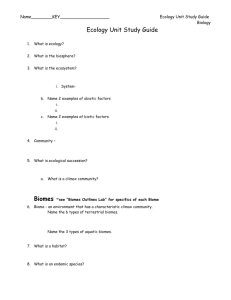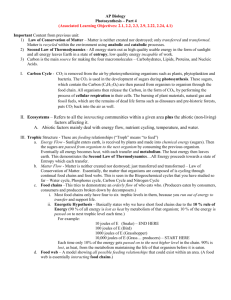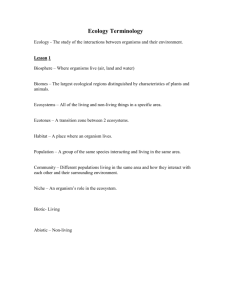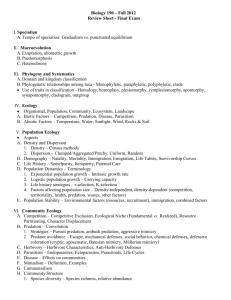6.3 Community Ecology Outline
advertisement
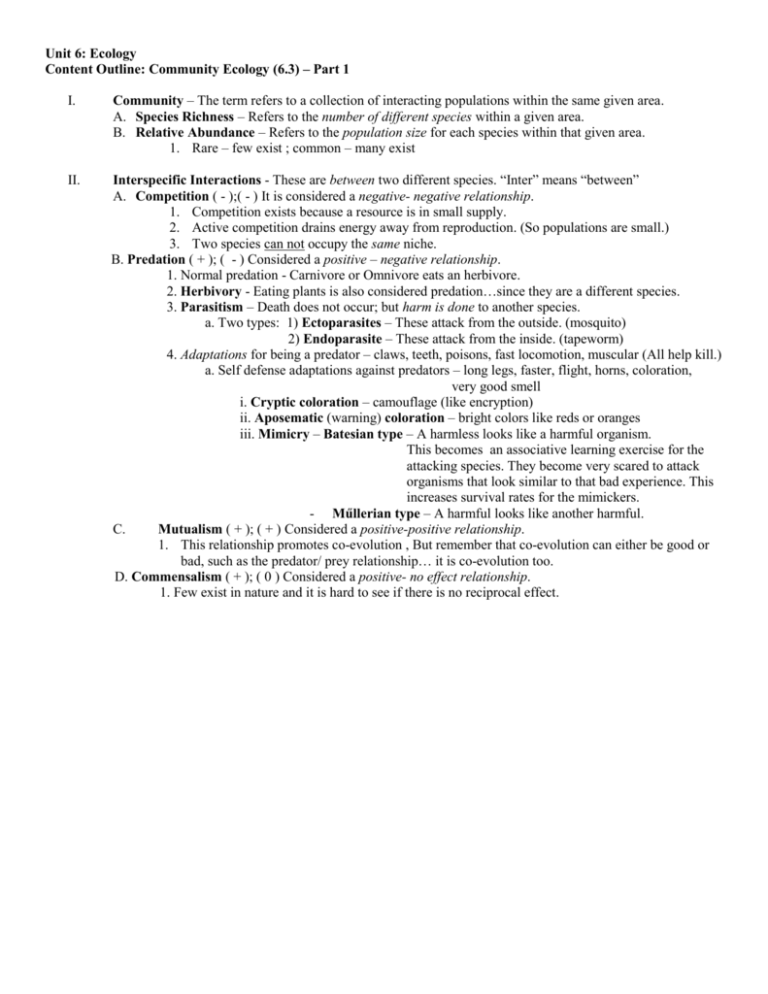
Unit 6: Ecology Content Outline: Community Ecology (6.3) – Part 1 I. Community – The term refers to a collection of interacting populations within the same given area. A. Species Richness – Refers to the number of different species within a given area. B. Relative Abundance – Refers to the population size for each species within that given area. 1. Rare – few exist ; common – many exist II. Interspecific Interactions - These are between two different species. “Inter” means “between” A. Competition ( - );( - ) It is considered a negative- negative relationship. 1. Competition exists because a resource is in small supply. 2. Active competition drains energy away from reproduction. (So populations are small.) 3. Two species can not occupy the same niche. B. Predation ( + ); ( - ) Considered a positive – negative relationship. 1. Normal predation - Carnivore or Omnivore eats an herbivore. 2. Herbivory - Eating plants is also considered predation…since they are a different species. 3. Parasitism – Death does not occur; but harm is done to another species. a. Two types: 1) Ectoparasites – These attack from the outside. (mosquito) 2) Endoparasite – These attack from the inside. (tapeworm) 4. Adaptations for being a predator – claws, teeth, poisons, fast locomotion, muscular (All help kill.) a. Self defense adaptations against predators – long legs, faster, flight, horns, coloration, very good smell i. Cryptic coloration – camouflage (like encryption) ii. Aposematic (warning) coloration – bright colors like reds or oranges iii. Mimicry – Batesian type – A harmless looks like a harmful organism. This becomes an associative learning exercise for the attacking species. They become very scared to attack organisms that look similar to that bad experience. This increases survival rates for the mimickers. - Műllerian type – A harmful looks like another harmful. C. Mutualism ( + ); ( + ) Considered a positive-positive relationship. 1. This relationship promotes co-evolution , But remember that co-evolution can either be good or bad, such as the predator/ prey relationship… it is co-evolution too. D. Commensalism ( + ); ( 0 ) Considered a positive- no effect relationship. 1. Few exist in nature and it is hard to see if there is no reciprocal effect. Community Ecology (6.3) – Part 2 I. Trophic Structure (Feeding Relationships)( “Troph” means “to feed”) A. Matter Cycles -Materials (matter) get recycled within the environment. (This is related to the Law of Conservation of Matter… Matter is neither created nor destroyed… only transferred and transformed.) B. Energy Flow - Sunlight enters earth, is received by plants and made into Chemical Energy (sugars). Then the sugars are passed from organism to the next organism by consuming the previous organism. Eventually all energy becomes heat with each transfer and metabolism, which then the heat energy leaves earth. (Demonstrates the Second Law of Thermodynamics…All Energy proceeds towards a state of Entropy which each transfer.) C. Food chains –This tries to demonstrate an orderly flow of who eats who. (Producers eaten by consumers, consumers and producers broken down by decomposers.) 1. Most food chains only have four to five trophic levels in them, because you run out of energy to transfer and support life. 2. The 10 % rule of E (90 % of all energy is lost as heat by metabolism of that organism; 10 % of the energy is passed on to next trophic level each time.) For example: 10 joules of E (Snake) – END HERE 100 joules of E (Mouse) 1000 joules of E (Grasshopper) 10,000 joules of E (Grass/flower… producers) – START HERE Each time only 10% of the E gets passed on to the next higher level in the chain. 90% is lost on the metabolism maintaining the life of that organism before it is eaten or as waste. D. Food web – A model showing all possible feeding relationships that could exist within an area. (A food web is essentially interacting food chains.) Community Ecology (6.3) – Part 3 I. Stability – A community at equilibrium. (Very little disturbance/change occurs over time.) II. Ecological Succession – Change in community composition due to time and disturbance. A. Two types can occur within environments 1. Primary Succession – This is “starting from scratch” using pioneer species – lichens and mosses. a. Hawaii going from barren volcanic rock to plush, tropical island. b. Pioneers make the dirt needed for the plants & birds bring seeds in their feces as they feed upon lichens. c. Lichens grasses bushes gymnosperms hardwood trees Climax d. Climax Community – Hardwood forest exists all over the specific area. 2. Secondary Succession – This is “starting over at the grasses level” not from scratch. (Such as the farming of fields to grow crops.) a. Dirt already exists. b. Grasses bushes Gymnosperms hardwood trees Climax




